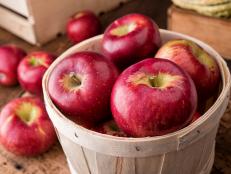What Is Apple Cider?
And what’s the difference between apple cider and apple juice?

K_Thalhofer/Getty Images
By Layla Khoury-Hanold for Food Network Kitchen
Layla Khoury-Hanold is a contributor at Food Network.
Autumn is synonymous with apples, which goes hand in hand with apple cider. You may have sipped cider after a day picking apples at a local farm or made mulled cider at home. But what exactly is apple cider? And what’s the difference between apple cider and apple juice? Here, we answer all your pressing apple cider questions.
What Is Apple Cider?
Apple cider is a raw, unfiltered, unsweetened beverage made from the juice of pressed apples that contains no alcohol.
Should You Drink Apple Cider Hot or Cold?
Apple cider can be enjoyed either hot or cold, either straight up or mixed into beverages. For a refreshing, spirit-free take on a whiskey sour, try a Mock Apple-Cider Sour. For a warming seasonal sipper, simmer apple cider with a cinnamon stick, cloves and orange slices to make Mulled Cider (add a splash of bourbon to take things boozy). For a doubly delicious pairing, serve cups of Hot Spiced Cider Tea with homemade Apple Cider Doughnuts or Apple Cider Snickerdoodles.
Does Apple Cider Contain Alcohol?
Apple cider can be made into a fermented, alcoholic beverage called cider or hard cider. It can be consumed chilled, hot or at room temperature. For a warm-you-to-your-toes libation, try this make-ahead Slow Cooker Hard Cider (as a bonus, it makes your place smell amazing).

tacojim/Getty Images
What Is the Difference Between Apple Juice and Apple Cider?
Both apple juice and apple cider are made from the juice of pressed apples. The main difference between apple cider and apple juice is how they are processed. Apple cider is raw, unfiltered, and unsweetened, and is typically sold unpasteurized (which makes it perishable and why it requires refrigeration). Apple juice is filtered to remove pulp and sediment, then pasteurized to extend its shelf life. Sometimes, sweetener is added to apple juice.
The production process also creates differences in flavor, appearance and texture between apple cider and apple juice. Since apple cider is unfiltered, it tends to have an opaque, sometimes cloudy appearance, a concentrated apple flavor with a pronounced earthiness and tanginess, and a sharper mouthfeel. Apple juice, which is filtered, is more transparent, tastes sweeter and has a smoother, rounder mouthfeel.

Natalia Ganelin/Getty Images
How to Make Apple Cider
It’s easy to learn how to make apple cider and chances are you’ve got most of the tools at home already (no apple cider press required!). It makes for a fun fall project, particularly if you’ve picked your own apples. Try making cider with one varietal or experiment with a mix of apples. For an even more detailed how to complete with photos and measurements, head over to our complete guide How to Make Apple Cider.
You will need: 4 apples, a knife, cutting board, food processor, potato ricer, food-grade fine-mesh bag (or cheesecloth) and a bowl (or liquid measuring cup)
- Cut the Apples: Chop apples into 1-inch cubes, including the skin, core and seeds.
- Process the Apples: In a food processor, pulse the cubes until they reach a pulpy, applesauce-like consistency.
- Press the Apples: Working in batches, add apple pulp to a food-grade fine-mesh bag set inside a potato ricer. Holding the potato ricer over a bowl or liquid measuring cup, squeeze the pulp to release the juice.
- Serve and Store the Cider: Enjoy the cider either cold or hot. Store leftovers in an airtight container in the refrigerator. It should last 7 to 10 days. (If the cider starts to get fizzy or taste acidic, that means it has started to naturally ferment and it’s best not to consume it.)
- Repurpose the Pulp: Use the leftover apple pulp to add moisture and a dose of apple-y sweetness to muffins, quick breads, pancakes or smoothies.
Related Links:































































